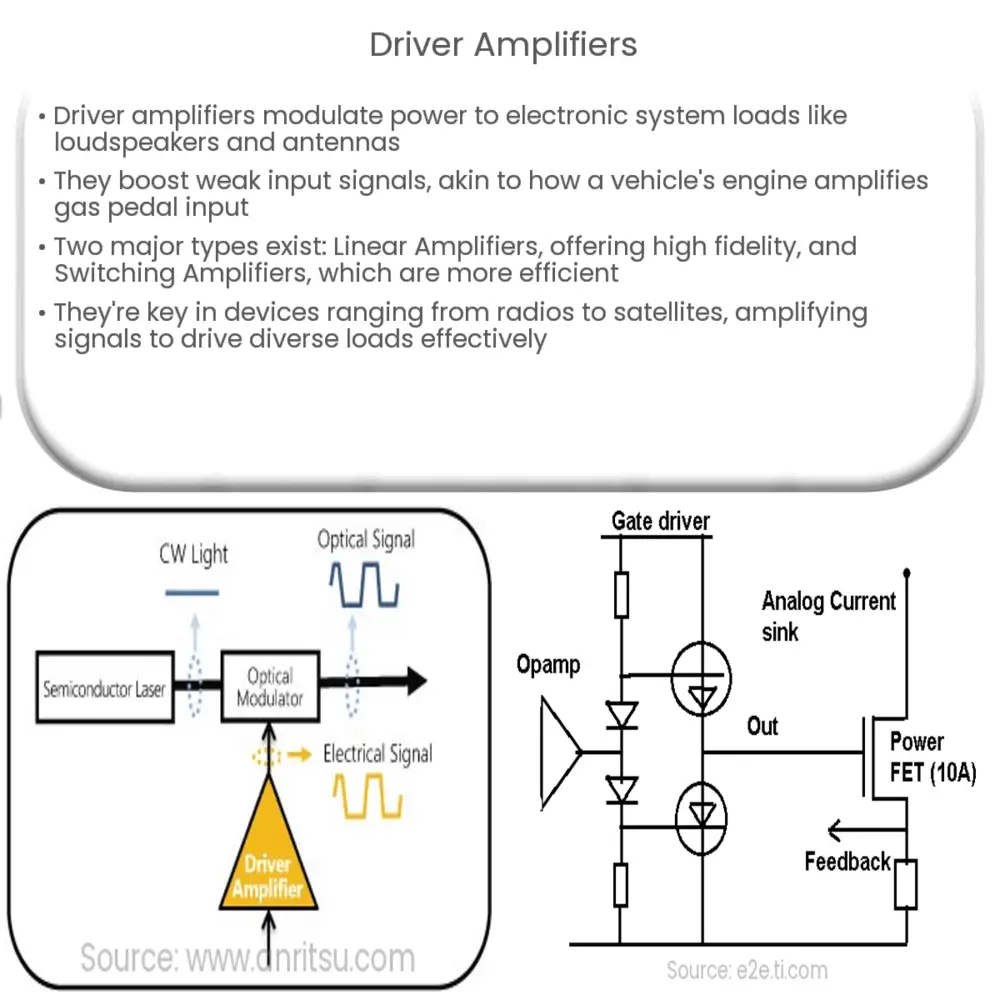Explore the vital role of driver amplifiers in electronics, their types, components, selection criteria, and broad-ranging applications.

Introduction to Driver Amplifiers
A Driver Amplifier, an integral component in electronic systems, serves to modulate the power supplied to a load, such as a loudspeaker, antenna, or another amplifier in a cascaded system. The primary purpose of this device is to augment the power level of an input signal so that it can effectively drive the load it’s coupled to, whether that’s for the purpose of sound reproduction, wireless transmission, or other applications.
The Principle Behind Driver Amplifiers
The basic concept behind a driver amplifier can be understood as a power booster. Its task is to take a weak input signal and amplify it, thereby making it capable of driving the intended load. A simple analogy would be a vehicle’s engine, which takes a small input from the gas pedal but translates that into significant energy to move the vehicle. Similar to how an engine drives the vehicle, the driver amplifier drives the load, hence the name.
Types of Driver Amplifiers
Driver amplifiers can be classified into two major categories:
- Linear Amplifiers: They work across their entire operational range, providing a broad bandwidth. These types of amplifiers have high fidelity, meaning the output signal is a true representation of the input signal, only with higher power.
- Switching Amplifiers: They operate by rapidly switching the signals between ‘on’ and ‘off’ states. These amplifiers are more efficient, as they tend to generate less heat.
Applications of Driver Amplifiers
From everyday electronics like radios and televisions to sophisticated systems like radar and communication satellites, driver amplifiers play an integral role.
- In audio systems, they’re used to boost the audio signal before it reaches the power amplifier, which then drives the loudspeaker.
- In the telecommunications industry, they are used in the transmission of radio and microwave signals.
- For scientific and industrial applications, they might be found in ultrasound imaging, spectroscopy, and other sensitive instrumentation where signal clarity and power are critical.
Thus, driver amplifiers, despite being less visible than many other electronic components, are nonetheless essential to the functionality of numerous systems.
Key Components of Driver Amplifiers
Driver amplifiers are complex pieces of technology, but there are a few key components that are generally present in all types.
- Input Stage: This is where the input signal first enters the amplifier. The input stage often includes some form of impedance matching to ensure the input signal is properly received.
- Gain Stage: This is where the actual amplification of the input signal occurs. The gain stage can consist of a single stage or multiple stages, depending on the specific design and purpose of the amplifier.
- Output Stage: Finally, this is where the amplified signal is delivered to the load. The output stage must be capable of delivering the necessary power to drive the load.
Choosing a Driver Amplifier
When selecting a driver amplifier for a specific application, there are several factors to consider:
- Gain: This determines how much the amplifier will boost the input signal. The required gain depends on the specific needs of the application.
- Output Power: This indicates how much power the amplifier can deliver to the load.
- Frequency Range: Different applications operate at different frequencies, so the amplifier must be compatible with the frequency range of the application.
- Efficiency: The efficiency of the amplifier determines how much input power is converted to output power, and how much is lost as heat. More efficient amplifiers run cooler and are often more reliable.
Conclusion
Driver amplifiers serve as the unsung heroes in electronic systems, amplifying signals and ensuring that they can adequately drive the loads they’re coupled to. Understanding the principle, types, applications, and key components of driver amplifiers gives insight into their vital role in countless devices, from consumer electronics to industrial systems and beyond. Whether it’s driving a loudspeaker in a sound system or transmitting signals in a telecommunications network, the driver amplifier’s role is crucial in ensuring effective and efficient operations.

